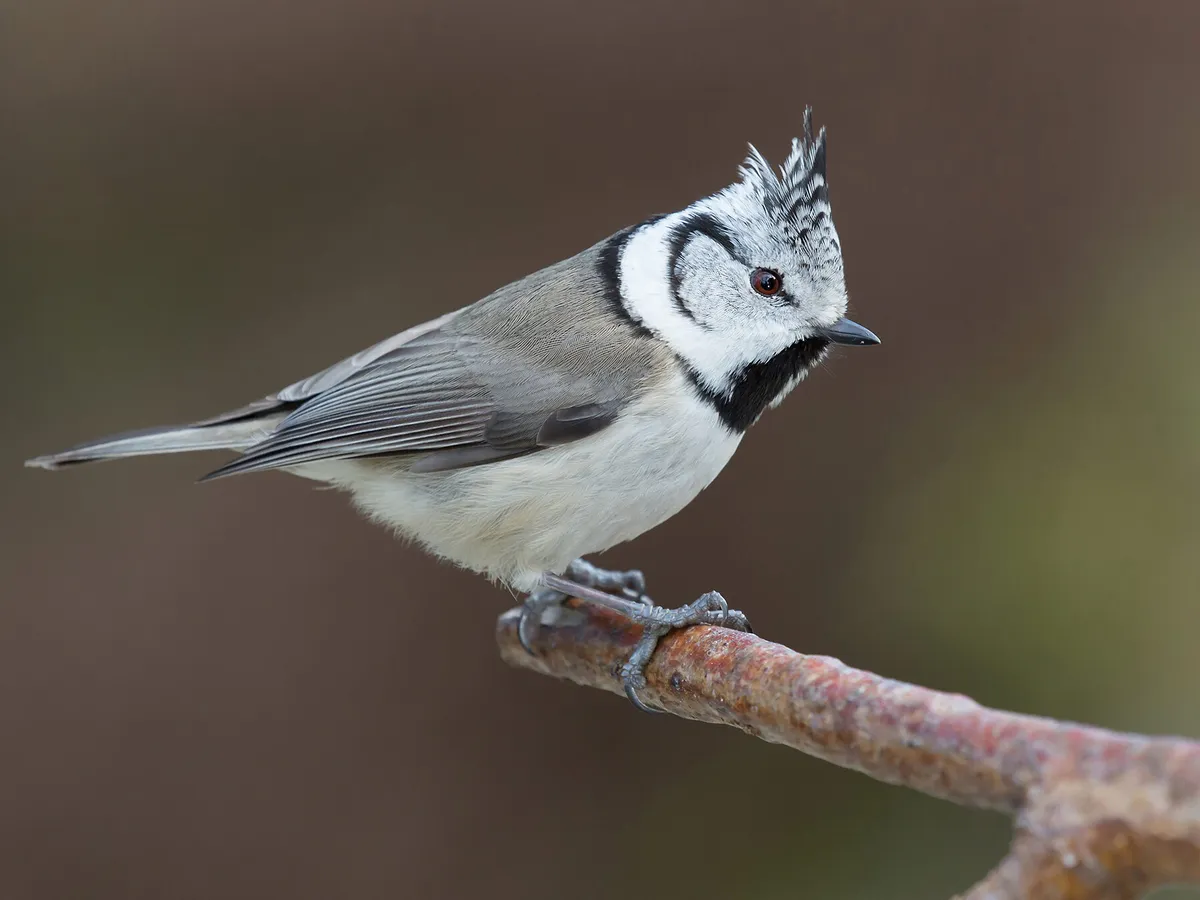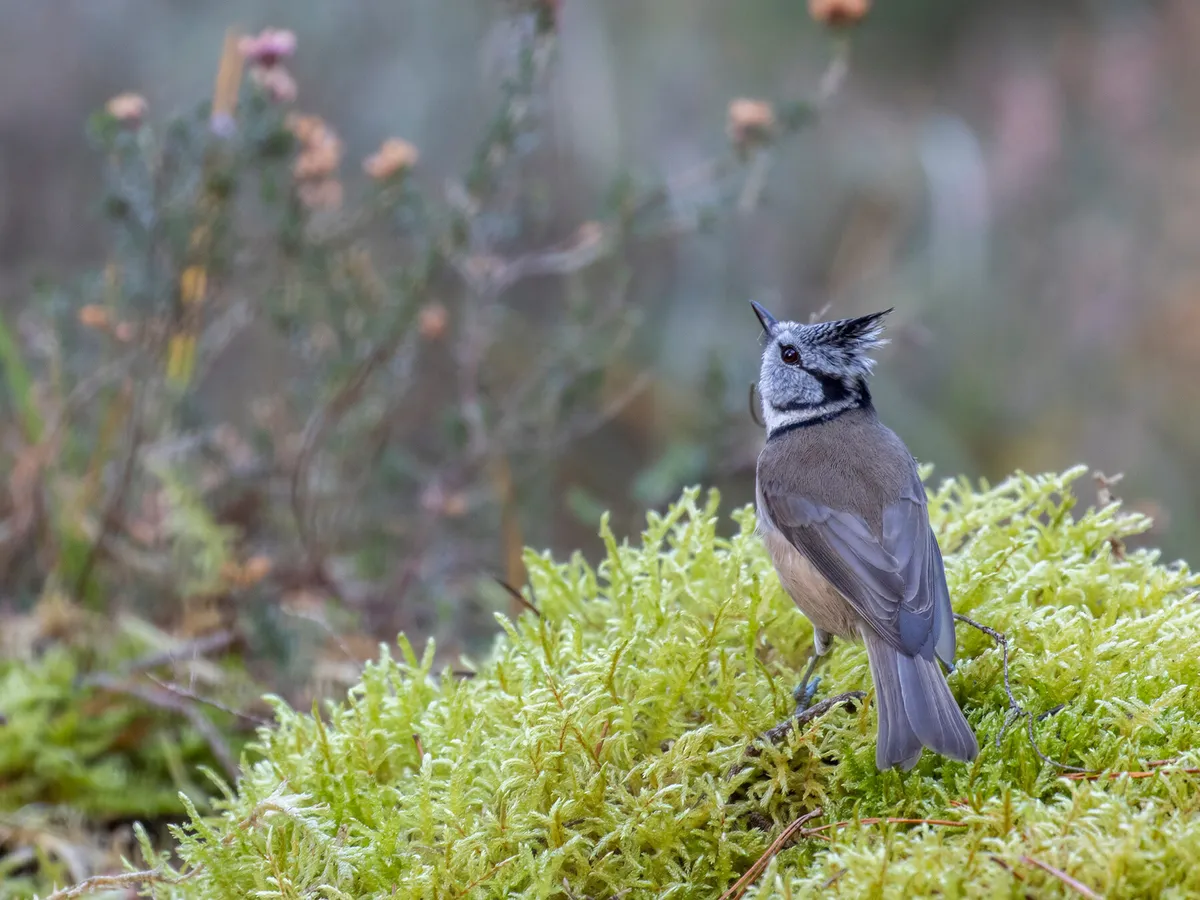The crested tit, which originates from Scotland’s historical Caledonian forests, stands out among other small British birds due to its punk-like crest. It is easy to identify because of this unique feature. During winter months, migratory crested tits may be seen in other regions.

Description of Crested Tit
How can we identify a crested tit?
Crested tits may not be the most vibrant tit species, but they have their own unique characteristics. Male crested tits can be identified by their buff-colored breast, grey-brown upper parts, and black throat and chin. Their tails are brownish-grey with darker edges, and they have black bills, grey-blue legs and feet, and light brown eyes. The defining feature of a crested tit is its short, spiky crest in black and white speckles. There is a thin black collar between the head plumage and the body, and a noticeable eye stripe that extends to the back of the head. The rest of the bird’s face is a creamy white.
Female crested tits are similar to males in size and color, but their crests are shorter and their striped feathers are narrower. Juvenile crested tits are browner than adult birds, and their crests are also shorter.

Have you ever wondered about the size of crested tits? Well, they are slightly smaller than blue tits and have a similar size to coal tits and marsh tits. In comparison to other birds commonly seen in gardens, the crested tit is larger than a wren but a bit smaller than a sparrow, dunnock, or chaffinch. Its length ranges from 11.5 to 12 cm, and it weighs around 10 to 13 g. Moreover, its wingspan measures 17 to 20 cm. When it comes to its sound, the crested tit produces a soft, purring trill as its song. Additionally, it makes a high-pitched ‘zee-zee-zee-cheera-cheera’ followed by a lower-pitched ‘choor’.

The crested tit’s diet consists of spiders and small insects found on the Caledonian pine trees in their habitat. During spring, they supplement their diet with Scots pine seeds that they extract from cones as they open. In autumn, pine looper moth larvae become a significant part of their diet. In the winter, they forage for heather on the forest floor. The crested tit stores food, including seeds and larvae, under lichen on branches and tree trunks to prepare for the scarcer food supplies in winter. When raising young, the adult crested tit consumes more insects and larvae to meet their protein needs. The chicks are fed tiny insects until they fledge, and then they join adults to forage for small larvae, spiders, and other insects on tree trunks and pine needles.

The crested tit is a bird species that enjoys residing in coniferous or mixed woodland habitats. Although they are predominant in well-established Scots pine plantations, they can also be found in deciduous woodlands with birch and alder trees. In north-central Scotland, these birds can be found inhabiting isolated coniferous forest regions. However, their range extends further throughout continental Europe, sweeping across the Iberian Peninsula, France, northern Europe, and western Russia all the way to the Ural Mountains.

The crested tit, a subspecies of the European crested tit, resides in specific areas of well-established Caledonian forest in Scotland. During winter, they form flocks and venture out to forage for insects. These forests provide them with year-round sources of food and shelter, allowing them to survive without needing to change their territory or leave their native habitat. In the UK, there are up to 2,000 resident breeding crested tits, and their numbers increase during the winter months with the arrival of migrants from northern Europe. While sightings on bird feeders have been reported further south into Wales and on the south coast of England, crested tits are mostly limited to specific tracts of Scottish Caledonian pine forest remnants and pine plantations in Easter Ross, the Beauly catchment, Strathspey, and along the coast of the Moray Firth. However, during winter, there are more opportunities to spot these birds, as migrant birds arrive from northern and central Europe and have been spotted further afield in South Wales and on the south and east coasts of England.

The lifespan and predators of crested tits are an interesting topic to explore. These cute little birds can live up to 7 years and 11 months, but their average life expectancy is around 2 years due to the threat of predation and starvation in winter. Unfortunately, crested tits have a few predators that pose a risk to their survival. Red squirrels and pine martens are known to raid their nests for eggs and young chicks, while adult birds are vulnerable to attacks from sparrowhawks. However, crested tits are protected under Schedule 1 of the Wildlife & Countryside Act 1981, ensuring they are safeguarded against disturbance when breeding and raising young. Despite the loss of ancient forest habitat impacting their population, the current number of resident breeders in the UK is stable and the species is considered of least concern.

The Crested Tit’s Nesting and Breeding Habits
When it comes to nesting, the Crested Tit has a particular preference for dead or rotting trees. They can either create their own hollows or use those already excavated by other animals such as squirrels or woodpeckers. The eggs of this bird are small, measuring just 16 by 13 mm and weighing 1.3 g on average. They are white with reddish-brown speckles and the clutch size usually ranges between 4 to 8 eggs. The Crested Tit is known to mate for life even though their lifespan is relatively short, averaging around two years. Both male and female birds take an active role in rearing their young, feeding them both in the nest and after they have fledged.

Crested tits are known to be social birds and do not exhibit territorial or aggressive behavior. These birds often form flocks with other bird species, such as coal tits, treecreepers, and goldcrests, and forage together for insects and larvae after breeding season ends. While crested tits are generally considered resident birds, some may migrate during winter months to access food supplies in warmer climates. Scottish crested tits tend to remain in their territories throughout the year, but vagrant birds from northern European countries may temporarily arrive in different parts of the British Isles to escape harsh winter conditions.



